Genre: Fighting Developer: Micronet Publisher: Micronet Players: 1-2 Released: 1991
Every once in a while, a game comes along that gets a lot of negative attention. It’s verbally kicked and beaten into the ground like it had just insulted a gamer’s mother, religion, and ethnicity. Some games are so bad, they deserve the abuse. However, every once in great a while, a game is black balled for being something that it isn’t… or at least, isn’t to the extent that many claim it is. How does Heavy Nova factor into this? Read on.
In the early 21st century, humans realize that the planet is suffering from thousands of years of pollution and war. They end their warring ways, but unfortunately, the best minds on Earth can’t figure out how to undo the damage done to the planet. Enter aliens from the planet Akirov, who have been studying Earth for 2,000 years. They come with the technology to clean the Earth’s air, land, and water. And soon, Earthlings and aliens live in peace together… but only for ten years. That’s when the plot to subjugate humans is discovered, and for eight more years, humans fight their planetary saviors using robots originally created for building space colonies. With the potential threat of future alien invasions looming, the cybernauts unit in control of the robots is named Heavy DOLLs (Defensive Offensive Lethal Liberators) after the war and charged with keeping the Earth safe. But during a time of peace, some of the Heavy DOLLs have gone rogue on one of the space stations. Can you make it through training, stop the rogue DOLLs, and become a Heavy DOLL yourself?
The first thing to be noticed visually in Heavy Nova, is the level of animation on the robots. Whether it’s walking, or getting back to their feet, nearly every motion has a good number of frames in it. Each robot is given this treatment, and it lends the game a level of fluidity not often found in Genesis games back in 1991. The robots are large, have some nice shading and details, and are designed well. The stages, while also having some detailed visuals themselves, are a bit barren in terms of their overall design. The backgrounds aren’t necessarily ugly, they just feel empty at times. And while it’s true that you’re supposed to be on an incomplete space station floating in empty space, one would still think a little more could have been done with them. They could have also used a shot of color, seeing as they rely on shades of gray a lot, which can lead to visibility issues since some of the robots also use shades of gray. Even so, the graphics in the game come off looking fairly well overall.
Aurally, the game is a mixed bag. The music is very well done. Enjoyable melodies and rhythms, and some rather impressive sounding instruments too. The sound effects, however, don’t share that trait. Some effects, like the punches and your robot hitting the ground, are pretty good. But other effects, like the mine laying ship that flies in, are rather odd and simply don’t fit at all. Also, there really aren’t that many effects, so you’ll encounter the same effect being used for different things. Guess the music didn’t leave much room for sound effects.
Now we come to Heavy Nova’s gameplay. This is where things get interesting. Even though this game is at heart a simplified fighting game, it also features short platforming sections. Between each fight, you’ll navigate areas with hazards like small robots, lasers, falling rocks, and mines. You’ll need to get through these obstacles, trigger switches, find the level up icons, and grab energy replenishers, as you make your way to the next robot you’re supposed to fight. It should also be said that this is not a fast action game. You can move quickly while hovering, but the rest of the game takes a slower pace during the levels and fights. Speaking of which…
The fights themselves are where the game takes a few rather bizarre turns. There are two buttons… a punch, and a kick. With these, you’ll have a rather healthy list of moves at your disposal, but which move you use depends on several factors. The first factor is whether you’re in front or behind the enemy. The second factor is what level you are. Each level up icon you get during the platforming sections grants you more moves, and this factoid brings up our third factor… how much attack energy you have.
Your attack energy is a line of thick dashes below your health meter, featuring red, orange, yellow and green bars. Having any of the three yellow and one green bar means you can attack. If you only have the two red bars, it means you’ll be laying on the ground unable to move at all (which can be fixed by hitting punch and kick rapidly back and forth while you’re on the ground), while having the orange bar means you can evade, but not attack. Also, several of the moves you earn require you to have a certain number of yellow/green bars in your attack energy, or you won’t be able to pull them off.
The fourth and final factor is how far away from the enemy you are. Add all this up, and you have a rather strange setup that decides which moves are performed at any given moment. Thankfully, these rules are fairly consistent, so you can plan attacks around them, and be pretty confident that the move you want will be the move that’s executed. Also of note, is that once you’re on your feet, you can only regain attack energy when you’re standing or walking (in other words, open to attack). If you squat down, hover, or jump, you’ll be immune to attacks, but you won’t regain any attack energy.
So, it sounds different, but potentially promising so far. Sadly, the game does have some glaring faults. One of the main issues with the game is that there are only four robots to choose from. Each has a set number of moves they can use. They do differ in attributes, but with only four, there’s not much of a selection. Another fault comes with the platforming sections. Frankly, they’re rather dull unless you’re in a strange mood to play them. Not many attackers, coupled with the slower game pace, can make getting through these areas tedious. This is especially true when the later levels become more maze-like in their design. Thankfully, you can turn these sections off in the options menu (making it fights only), which makes you wonder if the game designers felt the same way about them.
The game’s hit detection is a strange area. While it’s not perfect, for the most part it is alright. However, it will likely come off as being very poor for one big reason… the game has some rather unorthodox rules regarding when you can and can’t hit an opponent. Basically, you can only hurt them when they’re in a normal stance, when they missed with/are starting an attack, when they’re walking, or when they’re turning around. You can’t hurt them when they’re ducking, hovering, or in the process of ducking and jumping (be it starting to do so or recovering from having done so).
This oddness continues into the very close combat. When two robots are practically standing on top of one another, kicks and punches are basically useless unless your opponent has their back to you (or vice-versa). Then a jab will usually knock them down onto their face. Otherwise, unless someone performs a throw or grappling move, kicks and punches will likely just pass right through the robots again and again. Whether this trait is from the odd fighting system, actual bad hit detection during up close moments, or a mixture of the two, is up for grabs. Either way, it’s weird, and it’s likely going to turn a lot of people off because the whole thing doesn’t make for a natural feeling fighting system.
So, what do we have with Heavy Nova? We have a mediocre fighting game with nice animation, decent graphics, plenty of moves, and very good music, countered by a rather odd set of fighting rules, dull platforming sections, and not many robots to choose from. It tries to do its own thing but does so using an unnatural setup. This makes for a game that can be frustrating as hell if you’re not patient enough to wade through its quirks. Despite all this, if you stick with Heavy Nova long enough, and learn the game’s strange fighting system, you just may find that it can provide a little fun. It’s a tough call between a four and a five. But since you can turn off a couple problematic areas, and the fighting system is consistent enough to be learned and utilized, the game gets a nudge up to just barely be average.
SCORE: 5 out of 10

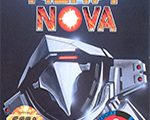
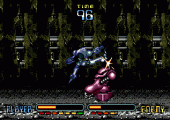
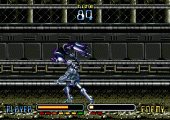
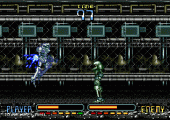
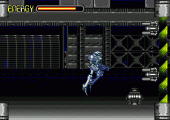
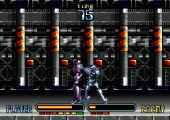

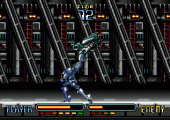

Quite the unfortunate mess of a game. The unresponsive controls and slow gameplay really spoil what could have otherwise been a good game. Makes you wonder if anyone play-tested this thing before they decided to sell it.